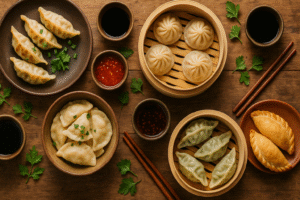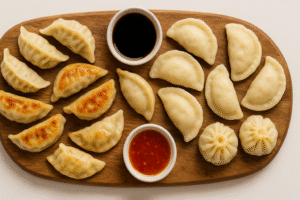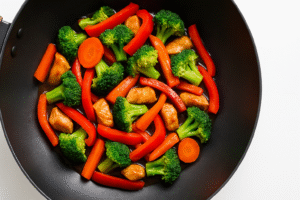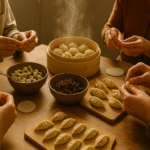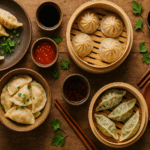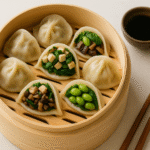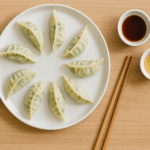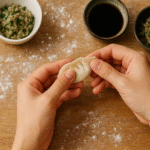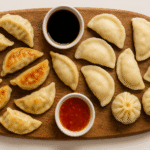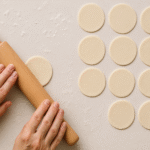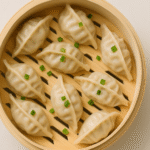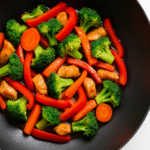Dumplings are simple in concept — dough wrapped around a savory or sweet filling — but mastering them requires skill and attention to detail. A perfectly made dumpling should be delicate yet sturdy, bursting with flavor, and cooked just right.
Whether you’re new to dumpling-making or improving your technique, understanding common mistakes can save time, reduce waste, and elevate your results.
This guide breaks down the most frequent errors home cooks make, along with expert tips on how to fix them.
The Most Common Dumpling Mistakes and How to Avoid Them
Overfilling the Wrapper
One of the biggest beginner errors is adding too much filling. This causes the dumpling to tear, leak, or cook unevenly.
Tip: Use about one teaspoon of filling for standard dumplings. The goal is to have enough space to seal the edges completely without stretching the wrapper too thin.
Wrappers Drying Out
Dumpling wrappers can dry quickly when exposed to air, becoming brittle and difficult to fold.
Tip: Keep wrappers covered with a clean, damp cloth while working. Once folded, place the finished dumplings under another cloth to prevent drying before cooking.
Poorly Sealed Edges
A dumpling that isn’t sealed tightly will burst during cooking.
Tip: Use a small bowl of water or egg wash to moisten the edges before folding. Press firmly to close and, if possible, pinch or pleat the edges for extra security.
Uneven Wrapping and Thickness
Thick or uneven dough prevents even cooking and may result in raw or tough areas.
Tip: Roll wrappers evenly to about 1–2 mm thickness. Aim for slightly thinner edges and a thicker center to balance texture.
Overcooking or Undercooking
Timing matters. Overcooked dumplings can become mushy, while undercooked ones remain doughy.
Tip: Steam for 8–10 minutes or pan-fry for about 6–8 minutes per batch, depending on size. When boiling, wait for dumplings to float, then cook for an additional 2–3 minutes.
Common Mistakes and Quick Fixes
| Mistake | Symptom | How to Fix It |
|---|---|---|
| Overfilled dumplings | Filling leaks out during cooking | Use less filling and leave room to seal |
| Dry wrappers | Cracked edges | Cover with a damp towel while folding |
| Weak seal | Dumplings burst open | Wet the edges before folding and press firmly |
| Uneven size | Some cook faster than others | Make uniform shapes and thickness |
| Soggy bottoms | Too much water or steam | Adjust heat and ventilation, pan-fry first before steaming |
Cooking Methods: Which One Works Best?
Each cooking technique delivers a different texture and flavor profile.
Steaming
Produces soft, tender dumplings that retain the original flavor of the filling. Best for delicate or vegetarian dumplings.
Boiling
Simple and fast, boiling makes dumplings light and moist. Ideal for larger, thicker dumplings such as jiaozi or mandu.
Pan-Frying
Combines crisp texture with a juicy interior. Perfect for gyoza or potstickers.
Deep-Frying
Used for crunchy dumplings like Mongolian khuushuur or Australian dim sims. Great for street-food style serving.
Expert Tips for Perfect Dumplings
- Prepare the Filling in Advance: Allow it to chill for 15–20 minutes before wrapping to make sealing easier.
- Avoid Excess Moisture: Squeeze water out of vegetables or tofu before mixing into the filling.
- Season Generously: Dumplings taste best when the filling is well seasoned — add soy sauce, sesame oil, and ginger for depth.
- Use Consistent Heat: Keep steam or oil at a steady temperature. Uneven heat leads to inconsistent texture.
- Serve Fresh: Dumplings taste best immediately after cooking; reheating can change their texture.
Step-by-Step Pan-Fried Dumpling Method
- Prepare the Filling: Mix minced pork (or chicken), cabbage, ginger, garlic, soy sauce, sesame oil, and salt.
- Wrap the Dumplings: Place a spoonful of filling in the center of each wrapper. Wet the edge and fold into a half-moon shape, pressing to seal.
- Pan-Fry: Heat oil in a non-stick pan over medium heat. Place dumplings flat side down and fry until golden.
- Steam: Add a small amount of water (about 1/4 cup), cover, and let steam for 5–6 minutes until cooked through.
- Uncover and Crisp: Remove the lid and continue frying for 1–2 minutes to restore crispness.
- Serve: Plate immediately with dipping sauces like soy, chili oil, or black vinegar.
FAQs
Steaming typically takes 8–10 minutes. Boil until the dumplings float, then cook for two more minutes to ensure the filling is done.
Yes. Store-bought wrappers are convenient and consistent. Just keep them covered to prevent drying.
Arrange uncooked dumplings on a tray without touching. Once frozen solid, transfer to a freezer bag. Cook directly from frozen.
If pan-frying, ensure enough oil covers the base and do not move dumplings immediately after placing them. Let a crust form before adding water to steam.
Steam them for a few minutes to rehydrate the wrapper without drying out the filling. Avoid microwaving as it can make them tough.
Conclusion
Making dumplings at home is a rewarding process that combines patience, technique, and creativity. By avoiding common mistakes and following these simple expert tips, you can achieve perfect dumplings every time — crisp on the outside, juicy on the inside, and packed with flavor.
Whether steamed, boiled, or pan-fried, every dumpling you make carries the satisfaction of craftsmanship and the taste of tradition.

